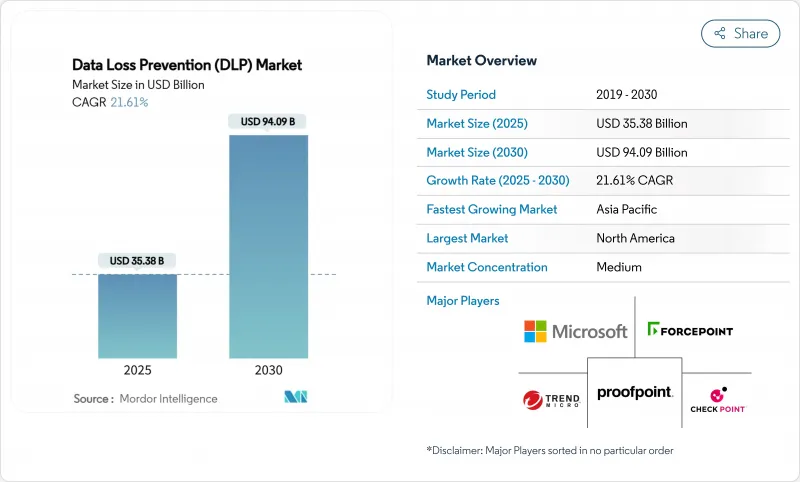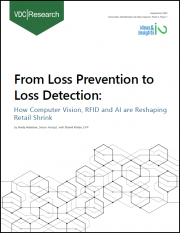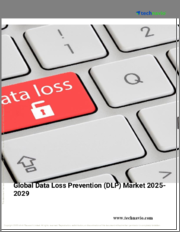
|
시장보고서
상품코드
1851712
데이터 유출 방지(DLP) : 시장 점유율 분석, 업계 동향, 통계, 성장 예측(2025-2030년)Data Loss Prevention (DLP) - Market Share Analysis, Industry Trends & Statistics, Growth Forecasts (2025 - 2030) |
||||||
데이터 유출 방지(DLP) 시장의 2025년 시장 규모는 353억 8,000만 달러로 평가되었고 2030년에는 940억 9,000만 달러에 이를 것으로 예측되며, 이 기간의 CAGR은 21.61%를 나타낼 전망입니다.

급속한 확장은 강화되는 규제 벌금, 하이브리드 업무 환경에 분산된 민감 데이터, 제로 트러스트 및 보안 액세스 서비스 엣지(SASE) 플랫폼 내 DLP 제어 기능 내재화에 기인합니다. 인공지능 정책 조정은 오탐률을 줄이고 분석가의 피로를 감소시켜 도입을 더욱 가속화하는 한편, 클라우드 기반 전개 모델은 분산된 사용자를 보호하기 위해 기업이 필요로 하는 탄력성을 제공합니다. DLP를 광범위한 데이터 보안 솔루션에 통합하는 인수합병으로 인한 벤더 통합은 엔드포인트, 네트워크, 멀티클라우드 환경 전반에 걸친 탐지, 분류, 보호 기능을 갖춘 통합 플랫폼으로의 전략적 전환을 강조합니다.
세계의 데이터 유출 방지(DLP) 시장 동향 및 인사이트
GDPR(EU 개인정보보호규정) 2.0과 CCPA 개정에 의한 사이버 침해에 대한 벌금 강화
최대 벌금이 지출 우선순위를 재편하고 있습니다. 동시에 영국 데이터(사용 및 접근) 법안은 데이터 처리 규정을 강화하고, EU AI 법안은 의무적 투명성 감사를 도입하여 모두 선제적 DLP 투자를 촉진하고 있습니다. 캘리포니아의 최신 CCPA 개정안은 민감한 개인정보의 정의를 확대하고 소비자 권리를 강화하여 전국적으로 운영되는 기업의 규정 준수 위험을 확대합니다. 관할권 전반에 걸쳐 경영진은 이제 강력한 DLP 기능을 선택적 사이버 보안 계층이 아닌 입증 가능한 위험 완화 조치로 인식하여 데이터 유출 방지 시장이 가속화된 성장을 이루도록 추진하고 있습니다.
하이브리드 근무 환경의 데이터 확산, 엔드포인트 및 클라우드 위험 증가
IBM의 2023년 침해 보고서에 따르면, 사건의 82%가 클라우드 상주 데이터를 포함했으며, 이는 경계 방어 체계의 붕괴를 강조합니다. 직원들은 점점 더 개인 기기와 승인되지 않은 SaaS 도구를 사용함으로써 기존 통제 수단이 모니터링할 수 없는 사각지대를 생성합니다. 제조업과 같이 운영 기술(OT)이 IT 시스템과 융합되는 분야에서는 생산 장비가 네트워크에 연결됨에 따라 공격 표면이 확대됩니다. 이에 기업들은 기기 수준 통제를 위한 엔드포인트 DLP를 도입하는 동시에 다중 공급자에 걸쳐 클라우드 DLP 규칙을 확장하며 데이터 유출 방지 시장 수요를 촉진하고 있습니다.
멀티클라우드 전개의 복잡성과 기술 격차
기업들은 일반적으로 3-5개의 클라우드 플랫폼을 운영하며, 각 플랫폼마다 고유한 접근 제어 및 암호화 방식을 갖추고 있습니다. 보안 팀은 전담 전문성 없이 정책을 조화시키기 위해 고군분투하며, 이는 전개 주기를 연장하고 운영 비용을 증가시킵니다. 따라서 클라우드 보안 인재 부족은 데이터 유출 방지 시장이 완전히 통합된 멀티클라우드 보호로 전환할 수 있는 속도를 제한합니다.
부문 분석
클라우드 기반 전개 모델은 2024년 67.3%의 시장 점유율을 확보했으며, 이 부문은 2030년까지 22.1%의 연평균 복합 성장률(CAGR)을 유지할 것으로 전망됩니다. 따라서 클라우드 서비스용 데이터 유출 방지 시장 규모는 기업 SASE(Secure Access Service Edge) 도입과 함께 확대될 것입니다. 클라우드 제공은 단일 콘솔 관리와 원격 사용자 전반에 걸친 탄력적인 정책 적용을 가능하게 하여 패치 및 하드웨어 교체 주기의 부담을 완화합니다. 방위나 중요 인프라 등 데이터가 물리적으로 통제된 위치에 반드시 보관되어야 하는 규제가 엄격한 분야에서는 온프레미스 솔루션이 여전히 사용됩니다. 그러나 하이브리드 근무 환경의 현실은 순수한 현장 전개로는 효율적으로 제공할 수 없는 어디서나 접근 가능한 검사 기능을 요구하기 때문에 상대적 성장은 둔화되고 있습니다.
Cloudflare의 SASE 프레임워크는 통합 DLP가 보안 웹 게이트웨이 및 CASB 스트림 내에서 정책 위반을 탐지하고 차단하는 방식을 보여줌으로써, 통합 서비스로 향하는 아키텍처 선호도의 변화를 입증합니다. 급속한 확장이나 계절적 데이터 급증을 겪는 조직은 사용량에 따라 비용이 책정되는 계량형 소비 모델의 혜택을 받으며, 이는 데이터 유출 방지 시장의 수요 증가 추세를 강화합니다.
엔드포인트 제어는 2024년 매출의 46.7%를 차지했으며 22.4%의 연평균 성장률(CAGR)로 가장 빠르게 성장하는 솔루션으로 남아, 기기 중심 데이터 처리의 급증을 반영합니다. 생성형 AI 코딩 어시스턴트의 확산은 엔드포인트 에이전트가 차단하기에 유리한 새로운 정보 유출 경로를 도입합니다. 연구진은 정상적인 구성 파일로 위장해 비밀 정보를 유출하는 '규칙 파일 백도어'를 시연하며 기존 검토 절차를 우회하는 방법을 보여주었습니다. 공급업체들은 이제 행동 기반 AI를 내장해 클립보드 사용, 화면 캡처, 코드 생성 패턴을 모니터링함으로써 보호 정밀도를 높이고 데이터 유출 방지 시장 성장을 주도하고 있습니다.
네트워크 DLP는 특히 복잡한 캠퍼스 네트워크에서 전송 중인 데이터 검사에 대한 중요성을 유지합니다. 한편 스토리지 중심 도구는 데이터 센터 내 대용량 파일 공유를 보호합니다. 그럼에도 기업들은 직원들이 노트북, 모바일, 가상 데스크톱에서 직접 민감한 데이터에 접근하기 때문에 엔드포인트 우선 전략을 선호합니다. 마이크로소프트의 Purview 제품군은 엔드포인트 정책을 브라우저 트래픽과 SaaS 세션으로 확장하며, 플랫폼 벤더들이 데이터 거버넌스와 엔드포인트 원격 측정 데이터를 융합하는 방식을 보여줍니다.
데이터 유출 방지 시장은 전개(온프레미스, 클라우드 기반), 솔루션(네트워크 DLP, 엔드포인트 DLP 등), 최종 사용자 업계(은행, 금융서비스 및 보험(BFSI), IT, 통신, 제조 등), 용도(클라우드 스토리지 보안, 이메일 및 협업 보호 등), 지역별로 구분됩니다. 시장 예측은 금액(달러)으로 제공됩니다.
지역별 분석
북미는 2024년 전 세계 매출의 24.2%를 차지했으며, 이는 엄격한 연방 및 주 정부 규제와 제로 트러스트 프로그램 예산을 확보한 자본력 있는 민간 부문의 영향으로 분석됩니다. 미국 기관들은 사이버보안 및 인프라 보안국(CISA)이 발표한 SASE 설계도 내에서 DLP를 도입하고 있으며, 캐나다의 개인정보 보호 제도와 멕시코의 확장 중인 핀테크 생태계가 지역적 성장 동력을 더하고 있습니다. 높은 침해 비용과 성숙한 사이버 보험 시장은 고급 제어 수단에 대한 프리미엄을 유지하며, 데이터 유출 방지 시장의 기술 검증 장으로서 북미의 역할을 공고히 하고 있습니다.
아시아태평양 지역은 급속한 디지털화와 거주 데이터 저장을 의무화하는 주권 클라우드 법에 힘입어 21.1%의 연평균 성장률(CAGR)로 가속화될 것으로 전망됩니다. 중국의 사이버보안법과 인도의 디지털 개인 데이터 보호법은 현지화된 정책 조율을 강제하여, 클라우드 기반이면서도 관할권 인식 기능을 갖춘 솔루션에 대한 지역적 수요를 촉진합니다. 일본과 한국은 제조 노하우 보호를 위해 엔드포인트 DLP를 도입하는 반면, 아세안(ASEAN) 경제권은 DLP와 보안 웹 게이트웨이를 결합한 클라우드 네이티브 스택으로 도약하고 있습니다. 이러한 규제와 위협 노출 요소가 복합적으로 작용하며 아시아태평양 지역을 데이터 유출 방지 시장에서 가장 역동적인 무대로 자리매김하게 합니다.
유럽의 성장은 GDPR 시행과 금융 기관의 최소 통제 기준을 높이는 디지털 운영 복원력법(Digital Operational Resilience Act) 같은 보완 법규에 기반합니다. 독일과 영국은 강력한 은행 및 산업 부문을 통해 지출을 주도하는 반면, 프랑스는 현지 호스팅 DLP 서비스를 선호하는 주권 클라우드 프로젝트를 추진합니다. 남유럽 경제권은 보다 안정적인 속도로 DLP를 도입하지만, 범유럽적 프라이버시 바이 디자인(Privacy-by-Design) 의무는 공급업체 제품에 보편적으로 영향을 미칩니다. 클라우드 아웃소싱 지침 내 데이터 현지화 조항은 국경을 넘어 정책 충실도를 유지할 수 있는 플랫폼에 대한 관심을 촉진하여 데이터 유출 방지 시장의 점진적 성장을 지속시키고 있습니다.
기타 혜택 :
- 엑셀 형식 시장 예측(ME) 시트
- 3개월간의 애널리스트 지원
목차
제1장 서론
- 조사의 전제조건과 시장의 정의
- 조사 범위
제2장 조사 방법
제3장 주요 요약
제4장 시장 상황
- 시장 개요
- 시장 성장 촉진요인
- GDPR(EU 개인정보보호규정) 2.0과 CCPA 개정에 의한 사이버 침해에 대한 벌금 강화
- 하이브리드 근무로 인한 데이터 확산이 엔드포인트 및 클라우드 위험 증가
- DLP와 CASB 및 DSPM 플랫폼의 융합
- AI 지원 정책 조정으로 인한 오탐률 급감
- 통합 DLP를 의무화하는 제로 트러스트와 SASE의 로드맵
- 새로운 정보 유출 경로를 생성하는 제네레이션 AI 코드 코파일럿
- 시장 성장 억제요인
- 멀티클라우드 전개의 복잡성과 스킬 격차
- 기존 온프레미스 정책의 높은 총소유비용(TCO)
- 프라이버시 바이 디자인(Privacy-by-Design) 추진으로 인한 심층 콘텐츠 검사 제한
- 주권 클라우드(Sovereign-Cloud) 의무화로 인한 글로벌 정책 세트 분할
- 공급망 분석
- 규제 상황
- 기술의 전망
- Porter's Five Forces
- 신규 참가업체의 위협
- 공급기업의 협상력
- 구매자의 협상력
- 대체품의 위협
- 경쟁 기업간 경쟁 관계
- 시장의 거시경제 요인 평가
제5장 시장 규모와 성장 예측
- 전개별
- 온프레미스
- 클라우드 기반
- 솔루션별
- 네트워크 DLP
- 엔드포인트 DLP
- 스토리지/데이터센터 DLP
- 기타
- 최종 사용자 업계별
- BFSI
- IT 및 통신
- 정부 및 방위
- 헬스케어
- 소매 및 물류
- 제조업
- 기타
- 용도별
- 클라우드 스토리지 보안
- 이메일 및 협업 보호
- IP 보호 및 소스 코드 거버넌스
- 기타
- 지역별
- 북미
- 미국
- 캐나다
- 멕시코
- 남미
- 브라질
- 아르헨티나
- 기타 남미
- 유럽
- 독일
- 영국
- 프랑스
- 이탈리아
- 스페인
- 기타 유럽
- 아시아태평양
- 중국
- 일본
- 인도
- 한국
- 동남아시아
- 기타 아시아태평양
- 중동 및 아프리카
- 중동
- 사우디아라비아
- 아랍에미리트(UAE)
- 튀르키예
- 기타 중동
- 아프리카
- 남아프리카
- 나이지리아
- 이집트
- 기타 아프리카
- 북미
제6장 경쟁 구도
- 시장 집중도
- 전략적 동향
- 시장 점유율 분석
- 기업 프로파일
- Broadcom(Symantec)
- Microsoft
- Forcepoint
- Proofpoint
- Zscaler
- Trend Micro
- Check Point
- Cisco
- Palo Alto Networks
- CrowdStrike
- Netskope
- Trellix
- Digital Guardian(Fortra)
- CoSoSys
- GTB Technologies
- Spirion
- Safetica
- Code42
- Nightfall AI
- Cyera
- Fortinet
제7장 시장 기회와 장래의 전망
HBR 25.11.17The data loss prevention market is valued at USD 35.38 billion in 2025 and is forecast to reach USD 94.09 billion by 2030, translating into a vigorous 21.61% CAGR over the period.

Rapid expansion is rooted in mounting regulatory penalties, the dispersal of sensitive data across hybrid workplaces, and the embedding of DLP controls inside zero-trust and Secure Access Service Edge platforms. Artificial-intelligence policy tuning is further accelerating adoption by trimming false-positive rates and reducing analyst fatigue, while cloud-delivered deployment models deliver the elasticity enterprises need to secure distributed users. Vendor consolidation driven by acquisitions that fold DLP into broader data-security posture offerings underscores a strategic pivot toward unified platforms capable of discovery, classification, and protection across endpoints, networks, and multicloud estates.
Global Data Loss Prevention (DLP) Market Trends and Insights
Escalating Cyber-Breach Fines Under GDPR 2.0 and CCPA Amendments
Maximum penalties are reshaping spending priorities: TikTok's EUR 530 million (USD 624.18 million) fine in 2025 spotlighted regulators' readiness to levy record sanctions for lax data-transfer controls. In parallel, the UK Data (Use and Access) Bill tightens data-handling rules, and the EU AI Act introduces mandatory transparency audits, both driving proactive DLP investment. California's latest CCPA amendments widen the definition of sensitive personal information and strengthen consumer rights, expanding compliance exposure for enterprises operating nationwide. Across jurisdictions, executives now view robust DLP capability as a demonstrable risk-mitigation measure rather than a discretionary cybersecurity layer, propelling the data loss prevention market toward accelerated growth.
Hybrid-Work Data Sprawl Raising Endpoint and Cloud Risk
IBM's 2023 breach report revealed that 82% of incidents involved cloud-resident data, underscoring the erosion of perimeter defenses IBM. Employees increasingly use personal devices and unsanctioned SaaS tools, creating blind spots that traditional controls cannot monitor. In sectors such as manufacturing where operational technology merges with IT systems the attack surface widens as production gear becomes network-connected. Organizations therefore adopt endpoint DLP for device-level controls while extending cloud DLP rules across multiple providers, fuelling demand in the data loss prevention market.
Complexity and Skills Gap in Multi-Cloud Roll-Outs
Firms commonly operate three to five cloud platforms, each with unique access controls and encryption schemes. Security teams struggle to harmonize policies without dedicated expertise, lengthening deployment cycles and inflating operating costs. The shortage of cloud-security talent therefore restrains the pace at which the data loss prevention market can transition toward fully orchestrated multicloud protection.
Other drivers and restraints analyzed in the detailed report include:
- Convergence of DLP with CASB and DSPM Platforms
- AI-Assisted Policy Tuning Slashing False-Positive Rates
- High TCO for Legacy On-Prem Policies
For complete list of drivers and restraints, kindly check the Table Of Contents.
Segment Analysis
Cloud-based deployment models secured 67.3% market share in 2024, and this segment is projected to sustain a 22.1% CAGR through 2030. The data loss prevention market size for cloud services will therefore scale in parallel with enterprise SASE adoption. Cloud delivery enables single console management and elastic policy enforcement across remote users, mitigating the burdens of patching and hardware refresh cycles. On-prem solutions persist in heavily regulated sectors such as defense or critical infrastructure where data must remain within physically controlled locations. Yet their relative growth is subdued because hybrid-work realities demand anywhere-access inspection that pure on-site deployments cannot deliver efficiently.
Cloudflare's SASE framework illustrates how integrated DLP detects and blocks policy violations within secure web gateway and CASB streams, demonstrating the architectural preference shift toward converged services. Organizations scaling rapidly or dealing with seasonal data spikes benefit from metered consumption models that align cost with usage, thereby reinforcing the demand trajectory of the data loss prevention market.
Endpoint controls accounted for 46.7% of revenue in 2024 and remain the fastest advancing solution at 22.4% CAGR, reflecting the surge in device-centric data handling. The rising prevalence of generative-AI coding assistants introduces novel exfiltration vectors that endpoint agents are uniquely positioned to intercept. Researchers demonstrated a "rules file backdoor" that smuggles secrets via benign-looking configuration files, bypassing conventional reviews. Vendors now embed behavioral AI to monitor clipboard use, screen capture, and code-generation patterns, increasing protection precision and powering growth in the data loss prevention market.
Network DLP preserves relevance for in-flight data scrutiny, especially in complex campus networks. Meanwhile, storage-centric tools protect high-volume file shares inside data centers. Nonetheless, enterprises gravitate toward endpoint-first strategies because employees engage with sensitive data directly on laptops, mobiles, and virtual desktops. Microsoft's Purview suite extends endpoint policies into browser traffic and SaaS sessions, signalling how platform vendors fuse data governance with endpoint telemetry.
Data Loss Prevention Market is Segmented by Deployment (On-Premises, Cloud-Based), Solution (Network DLP, Endpoint DLP, and More), End-User Industry (BFSI, IT and Telecom, Manufacturing, and More), Application (Cloud Storage Security, Email and Collaboration Protection, and More), and by Geography. The Market Forecasts are Provided in Terms of Value (USD).
Geography Analysis
North America commanded 24.2% of global revenue in 2024, anchored by stringent federal and state regulations plus a well-capitalized private sector that budgets for zero-trust programs. United States agencies embrace DLP inside SASE blueprints published by the Cybersecurity and Infrastructure Security Agency, while Canada's privacy regime and Mexico's expanding fintech ecosystem add regional momentum. High breach costs and mature cyber-insurance markets sustain a premium on advanced controls, consolidating North America's role as a technology proving ground for the data loss prevention market.
Asia-Pacific is forecast to accelerate at 21.1% CAGR, catalyzed by rapid digitization and sovereign-cloud laws that mandate resident data storage. China's Cybersecurity Law and India's Digital Personal Data Protection Act compel localized policy orchestration, driving regional demand for cloud-delivered yet jurisdiction-aware solutions. Japan and South Korea deploy endpoint DLP to safeguard manufacturing know-how, while ASEAN economies leapfrog to cloud-native stacks that bundle DLP with secure web gateways. This regulatory and threat-exposure cocktail positions APAC as the most dynamic arena within the data loss prevention market.
Europe's growth rests on GDPR enforcement and complementary statutes such as the Digital Operational Resilience Act, which raise minimum control baselines for financial entities. Germany and the United Kingdom anchor spending through robust banking and industrial sectors, whereas France advances sovereign-cloud projects that favor locally hosted DLP services. Southern European economies adopt DLP at a steadier pace, yet pan-EU privacy-by-design mandates universally influence vendor offerings. Data localization clauses inside cloud-outsourcing guidelines spur interest in platforms capable of maintaining policy fidelity across borders, sustaining incremental gains for the data loss prevention market.
- Broadcom (Symantec)
- Microsoft
- Forcepoint
- Proofpoint
- Zscaler
- Trend Micro
- Check Point
- Cisco
- Palo Alto Networks
- CrowdStrike
- Netskope
- Trellix
- Digital Guardian (Fortra)
- CoSoSys
- GTB Technologies
- Spirion
- Safetica
- Code42
- Nightfall AI
- Cyera
- Fortinet
Additional Benefits:
- The market estimate (ME) sheet in Excel format
- 3 months of analyst support
TABLE OF CONTENTS
1 INTRODUCTION
- 1.1 Study Assumptions and Market Definition
- 1.2 Scope of the Study
2 RESEARCH METHODOLOGY
3 EXECUTIVE SUMMARY
4 MARKET LANDSCAPE
- 4.1 Market Overview
- 4.2 Market Drivers
- 4.2.1 Escalating cyber-breach fines under GDPR 2.0 and CCPA amendments
- 4.2.2 Hybrid-work data sprawl raising endpoint and cloud risk
- 4.2.3 Convergence of DLP with CASB and DSPM platforms
- 4.2.4 AI-assisted policy tuning slashing false-positive rates
- 4.2.5 Zero-trust and SASE road-maps mandating integrated DLP
- 4.2.6 Gen-AI code copilots creating new exfiltration vectors
- 4.3 Market Restraints
- 4.3.1 Complexity and skills gap in multi-cloud roll-outs
- 4.3.2 High TCO for legacy on-prem policies
- 4.3.3 Privacy-by-design push limiting deep content inspection
- 4.3.4 Sovereign-cloud mandates fragmenting global policy sets
- 4.4 Supply-Chain Analysis
- 4.5 Regulatory Landscape
- 4.6 Technological Outlook
- 4.7 Porter's Five Forces
- 4.7.1 Threat of New Entrants
- 4.7.2 Bargaining Power of Suppliers
- 4.7.3 Bargaining Power of Buyers
- 4.7.4 Threat of Substitutes
- 4.7.5 Intensity of Competitive Rivalry
- 4.8 Assesment of Macroeconomic Factors on the market
5 MARKET SIZE AND GROWTH FORECASTS
- 5.1 By Deployment
- 5.1.1 On-premise
- 5.1.2 Cloud-based
- 5.2 By Solution
- 5.2.1 Network DLP
- 5.2.2 Endpoint DLP
- 5.2.3 Storage / Datacenter DLP
- 5.2.4 Others
- 5.3 By End-user Industry
- 5.3.1 BFSI
- 5.3.2 IT and Telecom
- 5.3.3 Government and Defense
- 5.3.4 Healthcare
- 5.3.5 Retail and Logistics
- 5.3.6 Manufacturing
- 5.3.7 Others
- 5.4 By Application
- 5.4.1 Cloud Storage Security
- 5.4.2 Email and Collaboration Protection
- 5.4.3 IP Protection and Source-code Governance
- 5.4.4 Others
- 5.5 By Geography
- 5.5.1 North America
- 5.5.1.1 United States
- 5.5.1.2 Canada
- 5.5.1.3 Mexico
- 5.5.2 South America
- 5.5.2.1 Brazil
- 5.5.2.2 Argentina
- 5.5.2.3 Rest of South America
- 5.5.3 Europe
- 5.5.3.1 Germany
- 5.5.3.2 United Kingdom
- 5.5.3.3 France
- 5.5.3.4 Italy
- 5.5.3.5 Spain
- 5.5.3.6 Rest of Europe
- 5.5.4 Asia-Pacific
- 5.5.4.1 China
- 5.5.4.2 Japan
- 5.5.4.3 India
- 5.5.4.4 South Korea
- 5.5.4.5 Southeast Asia
- 5.5.4.6 Rest of Asia-Pacific
- 5.5.5 Middle East and Africa
- 5.5.5.1 Middle East
- 5.5.5.1.1 Saudi Arabia
- 5.5.5.1.2 United Arab Emirates
- 5.5.5.1.3 Turkey
- 5.5.5.1.4 Rest of Middle East
- 5.5.5.2 Africa
- 5.5.5.2.1 South Africa
- 5.5.5.2.2 Nigeria
- 5.5.5.2.3 Egypt
- 5.5.5.2.4 Rest of Africa
- 5.5.1 North America
6 COMPETITIVE LANDSCAPE
- 6.1 Market Concentration
- 6.2 Strategic Moves
- 6.3 Market Share Analysis
- 6.4 Company Profiles (includes Global level Overview, Market level overview, Core Segments, Financials as available, Strategic Information, Market Rank/Share for key companies, Products and Services, and Recent Developments)
- 6.4.1 Broadcom (Symantec)
- 6.4.2 Microsoft
- 6.4.3 Forcepoint
- 6.4.4 Proofpoint
- 6.4.5 Zscaler
- 6.4.6 Trend Micro
- 6.4.7 Check Point
- 6.4.8 Cisco
- 6.4.9 Palo Alto Networks
- 6.4.10 CrowdStrike
- 6.4.11 Netskope
- 6.4.12 Trellix
- 6.4.13 Digital Guardian (Fortra)
- 6.4.14 CoSoSys
- 6.4.15 GTB Technologies
- 6.4.16 Spirion
- 6.4.17 Safetica
- 6.4.18 Code42
- 6.4.19 Nightfall AI
- 6.4.20 Cyera
- 6.4.21 Fortinet
7 MARKET OPPORTUNITIES AND FUTURE OUTLOOK
- 7.1 White-space and Unmet-Need Assessment



















